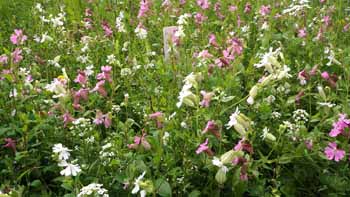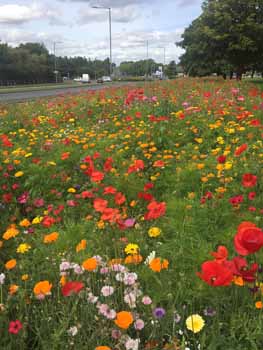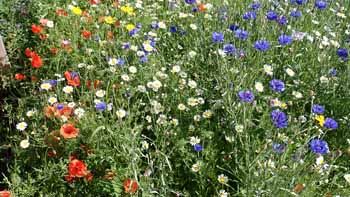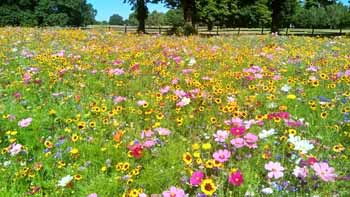Why flowers benefit a golf course
Flowers enrich the golf course environment, help reverse the decline of pollinating insects and enhance out of play areas that would otherwise require maintenance, writes Jayne Leyland.
The R&A promotes sustainability as a key priority for golf, with protecting nature and conserving resources at its core. Part of the enjoyment of playing golf is taken from its natural surroundings and boosting on-course biodiversity can enhance this experience and attract more positive publicity in general for the game of golf.

Flowers are a valuable resource for enriching the golf course environment, supporting biodiversity, producing stunning vistas and generally brightening up landscaping next to tees, along entrance driveways, water hazard embankments, roughs and borders around the clubhouse. Enhancing and naturalising out of play areas that would routinely require maintenance, for example mowing, means resources can be directed to the playing surfaces that matter most and therefore supporting the overall club profitability.
Euroflor flower seed, unlike ‘wildflower’ seed, is germination tested just like grass seed and similarly requires sufficient temperature and adequate moisture to germinate and establish. Low maintenance comes from just one cut per year in autumn when seeds have ripened and fallen. With a choice of annual or perennial mixes offering high visual impact or more discreet flowering displays, there is something to suit every course. Here are three examples:
- Euroflor Rainbow Annuals, a species diverse and vibrant mix for sowing April through early June for long lasting flowering vistas right through to the first frosts,
- Euroflor Boulevard, a low growing, majority perennial mix comprising only UK native and naturalised species for sowing spring or autumn, perfect for along driveways and in borders,
- Euroflor Cornfield Annuals, includes poppies and cornflowers for a splash of colour in the roughs, can be sown in spring or autumn.

The bee’s knees!
Euroflor Project Pollin-8 originated following research from the Urban Pollinators Group (UPG – a collaborative research programme on urban pollinators run by Bristol, Edinburgh, Leads and Reading universities) to help reverse the decline of pollinating insects. Sowing a variety of Euroflor mixes will ensure a longer seasonal supply of nectar and pollen and will support a far more diverse range of habitats for insects, invertebrates and small mammals. Here are three examples of mixes originating from that research:
- Euroflor Banquet, a mix of annuals, biennials and perennials, provides abundant pollen (for protein) and nectar (for energy) for bees, hoverflies, butterflies and other pollinating insects together with vibrant colour displays, sow spring or autumn,
- Euroflor Native Pollinator, comprises only UK native species, mainly perennials and biennials but with some annuals for first year colour, widely adaptable to a range of habitats and soil types, produces abundant nectar and pollen and native vegetation for egg-laying insects and larvae, sow spring or autumn,
- Euroflor Spring Flowers, sown in autumn for over winter vegetation followed by early spring blooms to provide a crucial early season supply of nectar and pollen, a second flush may appear in autumn if cut back late summer.

Spring sowing (April to early June)
Mixtures comprised of majority annual species when sown in late April, early May typically begin to flower from late June onwards, with a succession of different species flowering throughout the season for a constantly changing palate. The result is glorious flowering displays from summer right through to the first frosts of autumn. Both annual and perennial mixes can be spring sown. As a result of the ‘fantastic success’ of its displays of Rigby Taylor’s Euroflor urban meadow flower seed mixes, Kent-based stately home Hever Castle not only expanded the total area planted to more than 5,000 square metres, but also launched a retail scheme where ‘ready-to-sow’ flower seed kits are available for purchase by visitors.

The meadow flower project on the 400-acre estate and adjoining golf course, was initiated by Hever Castle Golf Club’s head greenkeeper Rob Peers to “encourage visitors to both the golf course and the estate to fully enjoy and be immersed by and engaged with the complete site”.
He says the project “has been an overwhelming success with the nine meadow areas – throughout the castle grounds and on areas of the golf course – which feature a wide range of flower species, attracting laudatory comments from visitors in person, in the local press and on social media.”

A little goes a long way!
At a sowing rate of just 3g per square metre, 1kg of Euroflor covers approximately 333 square metres, making it an extremely cost-effective as well as rewarding choice for enhancing the overall playing experience and biodiversity on the course. A little does indeed go a long way!

For more information, visit www.rigbytaylor.com or www.euroflor.co.uk or freephone 0800 424919















Let me tell You a sad story ! There are no comments yet, but You can be first one to comment this article.
Write a comment